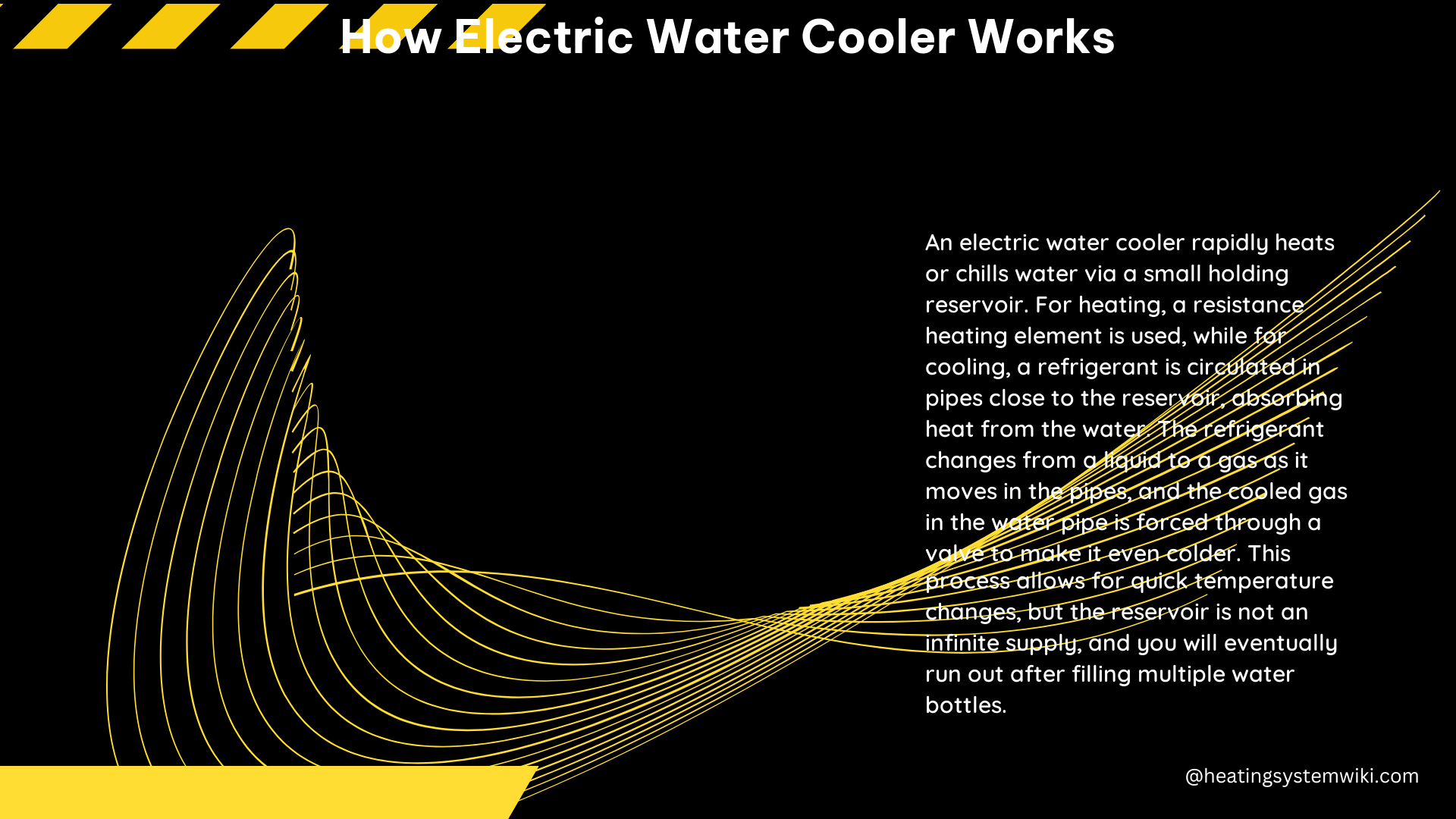An electric water cooler is a device that cools water by using a refrigerant, which is a cooling medium that is circulated in pipes close to a reservoir in the water cooler. The refrigerant changes from a liquid to a gas as it moves in the pipes towards the reservoir, causing it to become hot. The hot refrigerant is then passed through a condenser, which cools it down. The refrigerant is then squeezed through an expansion valve, which further decreases its temperature. The cold refrigerant is then passed through an evaporator, which transfers heat from the water to the refrigerant, leaving cool and refreshing water that is readily available for dispensing.
Understanding the Refrigeration Cycle
The electric water cooler works by using a compressor to compress the refrigerant, causing it to become hot. This is the first step in the refrigeration cycle. The hot refrigerant is then passed through a condenser, which is a heat exchanger that removes the heat from the refrigerant, causing it to condense back into a liquid.
The refrigerant is then squeezed through an expansion valve, which further decreases its temperature. This is the second step in the refrigeration cycle. The cold refrigerant is then passed through an evaporator, which is another heat exchanger that transfers heat from the water to the refrigerant, causing the refrigerant to evaporate back into a gas. This is the third step in the refrigeration cycle.
The refrigerant is then drawn back into the compressor, and the cycle repeats continuously to maintain the water at a cool temperature.
Key Components of an Electric Water Cooler

-
Compressor: The compressor is the heart of the electric water cooler. It is responsible for compressing the refrigerant, causing it to become hot. The compressor is typically a hermetically sealed unit that is powered by an electric motor.
-
Condenser: The condenser is a heat exchanger that removes the heat from the hot refrigerant, causing it to condense back into a liquid. The condenser is typically located on the back or side of the water cooler and is cooled by a fan.
-
Expansion Valve: The expansion valve is a device that further decreases the temperature of the refrigerant by reducing its pressure. This is the second step in the refrigeration cycle.
-
Evaporator: The evaporator is a heat exchanger that transfers heat from the water to the refrigerant, causing the refrigerant to evaporate back into a gas. This is the third step in the refrigeration cycle.
-
Reservoir: The reservoir is where the water is stored and cooled. It is typically located at the bottom of the water cooler and is insulated to keep the water cool.
-
Dispenser: The dispenser is the part of the water cooler that allows the user to dispense the cooled water. It is typically located at the front of the water cooler and has a button or lever that is used to dispense the water.
Technical Specifications of an Electric Water Cooler
Here are some typical technical specifications of an electric water cooler:
| Specification | Value |
|---|---|
| Power Supply | 110-120V AC, 60Hz |
| Power Consumption | 60-80W |
| Water Capacity | 1.5-2.0 gallons |
| Cooling Capacity | 2-3 gallons per hour |
| Refrigerant | R134a |
| Dimensions | 12″W x 12″D x 34″H |
| Weight | 30-40 lbs |
It’s important to note that the specific technical specifications may vary depending on the manufacturer and model of the electric water cooler.
Maintenance and Troubleshooting
To ensure the optimal performance and longevity of an electric water cooler, it’s important to perform regular maintenance. This includes:
-
Cleaning the Condenser Coils: The condenser coils should be cleaned periodically to remove any dust or debris that may have accumulated, which can reduce the efficiency of the cooling system.
-
Checking the Water Filter: The water filter should be replaced according to the manufacturer’s recommendations to ensure that the water remains clean and free of impurities.
-
Inspecting the Compressor: The compressor should be inspected periodically for any signs of wear or damage, and replaced if necessary.
-
Checking the Refrigerant Levels: The refrigerant levels should be checked periodically to ensure that the cooling system is operating at its optimal efficiency.
If the electric water cooler is not functioning properly, some common troubleshooting steps include:
-
Checking the Power Supply: Ensure that the water cooler is properly plugged in and that the power supply is functioning correctly.
-
Inspecting the Thermostat: Check the thermostat to ensure that it is set to the desired temperature and is functioning properly.
-
Checking for Leaks: Inspect the water cooler for any signs of leaks, which can indicate a problem with the cooling system.
-
Cleaning the Condenser Coils: As mentioned earlier, cleaning the condenser coils can help improve the efficiency of the cooling system.
By following these maintenance and troubleshooting steps, you can ensure that your electric water cooler continues to provide reliable and efficient cooling for years to come.
Conclusion
In conclusion, an electric water cooler is a convenient and efficient way to provide cool water in homes, offices, and other settings. It works by using a refrigeration cycle to transfer heat from the water to the refrigerant, leaving cool and refreshing water that is readily available for dispensing. The key components of an electric water cooler include the compressor, condenser, expansion valve, evaporator, reservoir, and dispenser. By understanding the technical specifications and performing regular maintenance, you can ensure that your electric water cooler continues to function at its best.
References
- Water Cooling Explained: How It Works and What Parts You Need, https://www.youtube.com/watch?v=iTD6Sayd8uw
- How Do Water Coolers Work?, https://bigspringswater.com.au/blogs/articles/how-do-water-coolers-work
- How does a water cooler work? | AquAid UK, https://www.aquaidwatercoolers.co.uk/how-does-a-water-cooler-work
- How Does A Water Cooler Work? – ScienceABC, https://www.scienceabc.com/innovation/how-does-a-water-cooler-work.html
- Eli5: how do those water dispensers heat and cool water so quickly?, https://www.reddit.com/r/explainlikeimfive/comments/o0twsd/eli5_how_do_those_water_dispensers_heat_and_cool/
